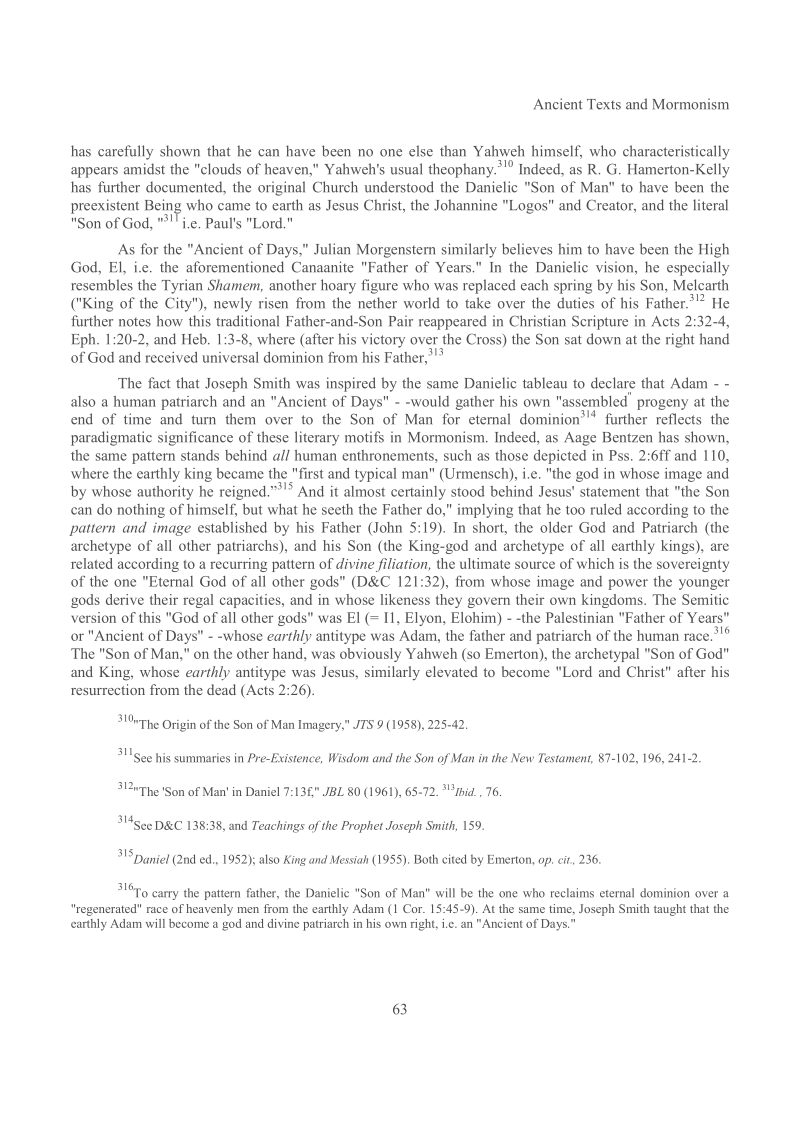Eugene Seaich interprets "Ancient of Days" to be a title; the "Ancient of Days" in Daniel 7 is not Adam/Michael but God the Father and Adam is his "earthly antitype."
- Type
- Book
- Source
- John Eugene Seaich LDS
- Hearsay
- DirectSecondary
- Reference
Eugene Seaich, Ancient Texts and Mormonism, 3rd ed., 6 vols. (Salt Lake City: Ronald W. Gibson, 2014), 1:65
- Scribe/Publisher
- Ronald W. Gibson
- People
- John Eugene Seaich
- Audience
- Reading Public
- Transcription
As for the "Ancient of Days," Julian Morgenstern similarly believes him to have been the High God, El, i.e. the aforementioned Canaanite "Father of Years." In the Danielic vision, he especially resembles the Tyrian Shamem, another hoary figure who was replaced each spring by his Son, Melcarth ("King of the City"), newly risen from the nether world to take over the duties of his Father. He further notes how this traditional Father-and-Son Pair reappeared in Christian Scripture in Acts 2:32-4, Eph. 1:20-2, and Heb. 1:3-8, where (after his victory over the Cross) the Son sat down at the right hand of God and received universal dominion from his Father,
The fact that Joseph Smith was inspired by the same Danielic tableau to declare that Adam - -also a human patriarch and an "Ancient of Days" - -would gather his own "assembled" progeny at the end of time and turn them over to the Son of Man for eternal dominion further reflects the paradigmatic significance of these literary motifs in Mormonism. Indeed, as Aage Bentzen has shown, the same pattern stands behind all human enthronements, such as those depicted in Pss. 2:6ff and 110, where the earthly king became the "first and typical man" (Urmensch), i.e. "the god in whose image and by whose authority he reigned.” And it almost certainly stood behind Jesus' statement that "the Son can do nothing of himself, but what he seeth the Father do," implying that he too ruled according to the pattern and image established by his Father (John 5:19). In short, the older God and Patriarch (the archetype of all other patriarchs), and his Son (the King-god and archetype of all earthly kings), are related according to a recurring pattern of divine filiation, the ultimate source of which is the sovereignty of the one "Eternal God of all other gods" (D&C 121:32), from whose image and power the younger gods derive their regal capacities, and in whose likeness they govern their own kingdoms. The Semitic version of this "God of all other gods" was El (= IL, Elyon, Elohim) - -the Palestinian "Father of Years" or "Ancient of Days" - -whose earthly antitype was Adam, the father and patriarch of the human race. The "Son of Man," on the other hand, was obviously Yahweh (so Emerton), the archetypal "Son of God" and King, whose earthly antitype was Jesus, similarly elevated to become "Lord and Christ" after his resurrection from the dead (Acts 2:26).
- BHR Staff Commentary
To carry the pattern farther, the Danielic "Son of Man" will be the one who reclaims eternal dominion over a "regenerated" race of heavenly men from the earthly Adam (1 Cor. 15:45-9). At the same time, Joseph Smith taught that the earthly Adam will become a god and divine patriarch in his own right, i.e. an "Ancient of Days." (Ibid., 1:65 n. 316)
- Citations in Mormonr Qnas
The B. H. Roberts Foundation is not owned by, operated by, or affiliated with the Church of Jesus Christ of Latter-day Saints.

